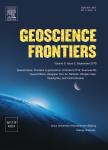Hydrothermally induced diagenesis: Evidence from shallow marinedeltaic sediments, WilhelmØya, Svalbard
Hydrothermally induced diagenesis: Evidence from shallow marinedeltaic sediments, Wilhelm?ya, Svalbard作者机构:Department of GeosciencesUniversity of Oslo Institute of Geological SciencesPolish Academy of Sciences School of GeosciencesChina University of Petroleum The University Centre in Svalbard (UNIS)
出 版 物:《Geoscience Frontiers》 (地学前缘(英文版))
年 卷 期:2019年第10卷第2期
页 面:629-649页
核心收录:
学科分类:07[理学] 0708[理学-地球物理学] 0704[理学-天文学]
基 金:(partially)funded by the project"Recon-structing the Triassic Northern Barents shelf basin inill patternscontrolled by gentle sags and faults"(Trias North-www.mn.uio.no/triasnorth/)under grant 234152 from the Research Council of Nor-way with financial support from Tullow Oil Norge,LundinNorway,Statoil Petroleum,Edison Norge and RWE Dea Norge
主 题:Diagenesis Sill intrusions Hydrothermal convection cells Carbonate cement Sericitization of feldspars
摘 要:Sedimentary basins containing igneous intrusions within sedimentary reservoir units represent an important risk in petroleum exploration. The Upper Triassic to Lower Jurassic sediments at Wilhelm?ya(Svalbard) contains reservoir heterogeneity as a result of sill emplacement and represent a unique case study to better understand the effect of magmatic intrusions on the general burial diagenesis of siliciclastic sediments. Sills develop contact metamorphic aureoles by conduction as presented in many earlier studies. However, there is significant impact of localized hydrothermal circulation systems affecting reservoir sediments at considerable distance from the sill intrusions. Dolerite sill intrusions in the studied area are of limited vertical extent(~12 m thick), but created localized hydrothermal convection cells affecting sediments at considerable distance(more than five times the thickness of the sill)from the intrusions. We present evidence that the sedimentary sequence can be divided into two units:(1) the bulk poorly lithified sediment with a maximum burial temperature much lower than 60-70 ℃,and(2) thinner intervals outside the contact zone that have experienced hydrothermal temperatures(around 140 ℃). The main diagenetic alteration associated with normal burial diagenesis is minor mechanical plastic deformation of ductile grains such as mica. Mineral grain contacts show no evidence of pressure dissolution and the vitrinite reflectance suggests a maximum temperature of ~40 ℃. Contrary to this, part of the sediment, preferentially along calcite cemented flow baffles, show evidence of hydrothermal alteration. These hydrothermally altered sediment sections are characterized by recrystallized carbonate cemented intervals. Further, the hydrothermal solutions have resulted in localized sericitization(illitization) of feldspars, albitization of both K-feldspar and plagioclase and the formation of fibrous illite nucleated on kaolinite. These observations suggest hydrothermal alteration at T 120-140 ℃ at distances considerably further away than expected from sill heat dissipation by conduction only, which commonly affect sediments about twice the thickness of the sill intrusion. We propose that carbonate-cemented sections acted as flow baffles already during the hydrothermal fluid mobility and controlled the migration pathways of the buoyant hot fluids. Significant hydrothermally induced diagenetic alterations affecting the porosity and hence reservoir quality was not noted in the noncarbonate-cemented reservoir intervals.



